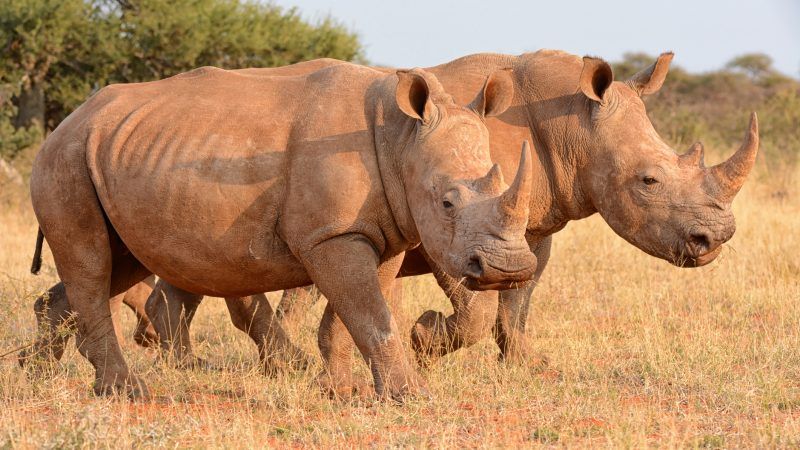U.N. Says 1 Million Species Will Go Extinct Without a 'Fundamental, System-wide Reorganization'
But predictions of the apocalypse are again likely overstated.

A new United Nations report warns that "global rate of species extinction is already at least tens to hundreds of times higher than the average rate over the past 10 million years and is accelerating." The only solution to the possible extinction of 1 million species: "Transformative change" in human society, according to the Intergovernmental Science-Policy Platform on Biodiversity and Ecosystem Services (IPBES). "By transformative change, we mean a fundamental, system-wide reorganization across technological, economic and social factors, including paradigms, goals and values," explained IPBES Chair Robert Watson in a press release. Recommended "transformative changes" include reducing human population growth, eschewing "overconsumption," and "addressing inequalities, especially regarding income and gender, which undermine capacity for sustainability."
How did the IPBES researchers come up with their estimate of 1 million species at risk of extinction? Among other things, they find that more than 40 percent of amphibian species, almost a third of reef-forming corals, sharks and shark relatives and over a third of marine mammals are currently threatened. There are about 8,000 known species of amphibians, 440 shark species, about 1,000 species of reef corals, and about 120 species of marine mammals. Parsing those numbers suggest that 3,680 or so species are at risk of extinction. Certainly not good, but far from 1 million. Insect extinction estimates are where the numbers really get boosted. The researchers claim that "available evidence supports a tentative estimate of 10 percent" for insect species at risk of extinction. Since insects make up around 75 percent of 8 million species this means that 600,000 species are at risk of extinction.
The IPBES report further bolsters its estimate of species at risk by making calculations based on the species area relationship that in general reckon if the size of an ecosystem is reduced by 90 percent, the number of different species it can sustain is cut by 50 percent. Since humans have "reduced global terrestrial habitat integrity by 30 percent relative to an unimpacted baseline" this suggests that "around 9 percent of the world's estimated 5.9 million terrestrial species—more than 500,000 species—have insufficient habitat for long-term survival." However, some researchers counter that species area curve calculations considerably overestimate extinction rates from habitat loss.
As noted above, another way the IPBES tries to figure out the number of future extinctions is to assert that the rate of species disappearance is accelerating. As I reported earlier, IPBES researchers estimated the background extinction rate without human influence is about 0.1 species per million species years. In other words, if you follow the fates of a million species, you would expect to observe about one species going extinct every 10 years. Given that the report estimates that the planet harbors around 8 million species, this suggests that around eight species naturally go extinct every 10 years.
It is worth noting that the International Union for Conservation of Nature recently reported that some 800 species are known to have gone extinct since 1500. Implausibly assuming that no unknown species met their demise during this period that nets out to an extinction rate that is about double (16 every 10 years) the natural background rate.
Boosting the natural background rate by a factor of 1,000 suggests that 8,000 species go extinct every 10 years, or 800 per year. At that rate, some 64,000 species—about 0.08 percent of species—could go extinct by the end of this century. The only way to get estimates of between a half million and a million extinctions using this method is to assume the extinction rate will accelerate to 10,000 times higher than the natural background rate.
A world bereft of giraffes, tigers, whooping cranes, hammerhead sharks, karner blue butterflies, and hellbender salamanders would indeed be a poorer place. However, many of the transformative changes advocated by the IPBES are already happening as a result of the economic growth the U.N. agency wants us to steer away from. Due to increasing wealth, education, and urbanization, world population will peak later this century at around 8 to 9 billion. As result of urbanization, the number of people living on the landscape will drop by half from 3.6 billion now to 1.8 billion by the end of this century. The result is more land spared for nature. With respect to concerns about "overconsumption," human ingenuity is dematerializing the economy by constantly squeezing more and more value out of less and less stuff. And to the extent that income and gender equality undergird a sustainable future, the good news is that both global income inequality and gender inequality is falling.
The IPBES report falls in a long line of apocalyptic extinction predictions. For example, S. Dillon Ripley of the Smithsonian Institution predicted in 1970 that in 25 years, somewhere between 75 and 80 percent of all the species of living animals would be extinct. That is, 75 and 80 percent of all species of animals alive in 1970 would be extinct by 1995. Fortunately, Ripley was wrong then and it is likely that the IPBES is wrong now.
